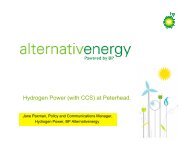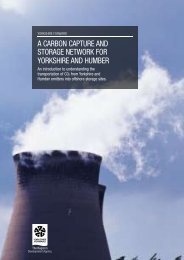Final report for One North East And NEPIC 21/12/10 - The Carbon ...
Final report for One North East And NEPIC 21/12/10 - The Carbon ...
Final report for One North East And NEPIC 21/12/10 - The Carbon ...
You also want an ePaper? Increase the reach of your titles
YUMPU automatically turns print PDFs into web optimized ePapers that Google loves.
<strong>The</strong> case <strong>for</strong> a Tees CCS network<strong>Final</strong> ReportGovernment‟s thinking. This leaves various options lying between these two extremes. Inthis context, two modes <strong>for</strong> project development and structuring are possible:1. Single entity promoter. This would require the emergence of a single, riskseeking,well-capitalised and/or creditworthy CO 2 capture plant owner ormidstream promoter stepping in to develop the project. However, such „midstream‟promoted projects are generally the most difficult projects to realise as thepromoter has little or no recourse to the underlying asset creating entities. It wouldrely on the development of watertight supply and off-take agreements, or a veryrobust demand-case <strong>for</strong> CO 2 ; the latter could only really come from EOR.2. Joint Venture (JV) development. This would involve a coalition of willing TeesValley (and potentially other) operators joining together to <strong>for</strong>m an investmententity (special purpose vehicle company; SPV) under which they would developthe onshore network, and potentially the initially over-sized offshore pipeline. Thiswould require these entities to put finance directly into the SPV as equity, and alsopossibly try to attract private capital into the project (debt), as described in theprevious section.6.1 Single „midstream‟ promoterA single promoter could involve a large company with appropriate expertise (e.g. E.On,BP, Shell, Linde, National Grid etc.) making the necessary investment, based on aspeculative view of the business case <strong>for</strong> the future use of the pipeline 93 . Whilst thesecompanies are not risk-averse, they would face significant opportunity costs.Smaller specialised promoters could also be interested. Progressive Energy hasestablished a shell company – COOTS – as a potential investment vehicle. However,whilst small companies may be risk-seeking, and have a single business model predicatedon CO 2 supply and demand, they would need to be suitably capitalised / creditworthy toattract the level of investment that would be needed to fund the Teesside onshore networkand offshore pipeline. Moreover, as highlighted above, as such companies would not haveany direct interests in the underlying value creating entities (i.e. CO 2 sources or EOR offtakes),they would face the greatest challenge to get the project off the ground. <strong>The</strong>re<strong>for</strong>e,in our view, the emergence of this option in isolation from operators in Teesside - seemsunlikely at the current time.6.2 Joint venture approach<strong>The</strong> JV model holds more promise. Equity involvement by operators of the underlyingassets that create value (i.e. the emission sources) would significantly de-risk the projectfrom the point of view of non-supply risk, probably the most important factor affecting thecommercial viability of the transport infrastructure. This could include the “anchor” projectsthat could gain UK CCS Demonstration finance, and potentially other Tees Valleyoperating companies that are well-capitalised and creditworthy entities (e.g. SembCorp,SABIC, GdF Suez). <strong>The</strong> involvement of these entities could significantly improve thechances of attracting private capital, either through share issues, corporate finance (debt)or, most likely, project finance (debt).93 This is how gas pipelines have been built in the past e.g. BP and partners built the CATS pipeline in view of theanticipated demand from many small gas fields in the Southern Central <strong>North</strong> Sea area, and recognising thatindividually none of the field developments could justify the investment into the pipeline, even though it madeeconomic sense in combination.58







